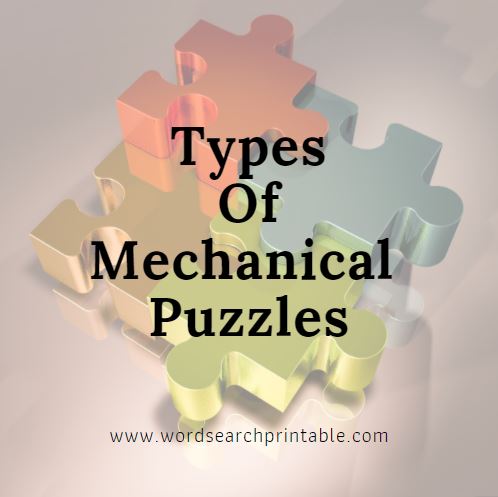Types Of Mechanical Puzzles
Puzzles! There are numerous types of puzzles and mechanical puzzles are one of the types. In this article below, we are going to look into various categories and types of mechanical puzzles. This genre of puzzles is usually designed for a single player. You can find the solution for a mechanical puzzle by trial and error method. Each category of the mechanical puzzles has different levels of difficulty depending on the complexity of the pieces used for designing it.
We found there are 10 types under mechanical puzzles. A typical mechanical puzzle is a puzzle that is designed using a number of pieces that are interlinked and requires one to manipulate the pieces with hands in order to find the solution for the puzzle.
For solving any type of mechanical puzzle you will have to manipulate the pieces using intelligence, logic, reasoning, or even one’s luck might come in handy in some instances of solving it! The types are Folding Puzzles, Vanish Puzzles, Puzzle Vessels, Sequential Movement Puzzles, Dexterity Puzzles, Take Apart Puzzles, Put Together Puzzles, Disentanglement Puzzles, Solid Interlocking Puzzles, Impossible Object Puzzles, Rotating Puzzles. Let us now look into each of them in detail.
1. Folding Puzzles
A mechanical puzzle is generally designed to be tough and folding type is one of the most difficult ones. A folding puzzle requires you to fold the piece in different directions so that the face of the folding puzzle results in showing a specific picture or an image. In other words, you need to manipulate one single piece of a puzzle (that has creases on it) with hands only with one physical movement i.e; folding, to form a meaningful image on top.
The older versions of folding puzzles are relatively easy since the newer version has hinges instead of just crease lines making it tougher to keep the foldings still. Folding puzzles these days are reasonably affordable and the price depends on the material used for designing them.
Here is an example of a folding type of mechanical puzzle.
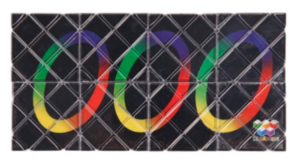
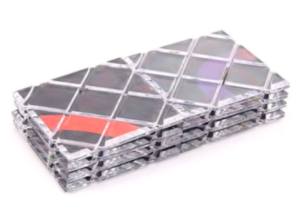
You need to fold the piece in different directions shown in the first image so that it forms the image shown in the second picture on the face of the puzzle.
2. Vanish Puzzles And Puzzle Vessels
Vanish puzzles are the ones that are designed in such a way that, the consequence of moving a piece in the puzzle is an image being vanished. In other words, a printed picture or another relatively smaller piece appears to have vanished when you move it in a specific direction. And puzzle vessels aka trick vessels, require you to fill or drink or pour out fluid with a hypothetical scenario hidden in solving it.
Vanish Puzzles and Puzzle Vessels can be used separately or for designing the same puzzle hence they are kept under one category of mechanical puzzles.
Here are the examples for puzzle vessels.

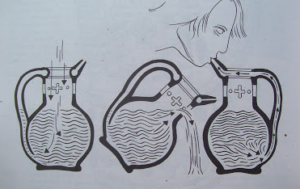
The first image shows you an image of a puzzle vessel, where you will be required to drink water from it. The procedure for solving it is in the second picture.
3. Sequential Movement Puzzles
As the name reveals, a sequential movement puzzle is a puzzle that needs to be solved by following a predetermined sequence or order of steps in order to achieve the goal that is set for calling it solved. To be precise, if a person could remember the sequence used for solving the puzzle, one can beat the record of time taken the next time one tries to solve it.
This type of mechanical puzzle has subtypes like sliding block, solitaire, route puzzles, etc. To finish solving a sequential movement type of puzzle, one needs to complete all the steps involved in the sequence. The solver needs to be okay with backtracking the steps or even with starting it again if got stuck somewhere.
Here are a few examples of sequential movement puzzles.
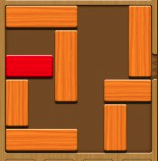
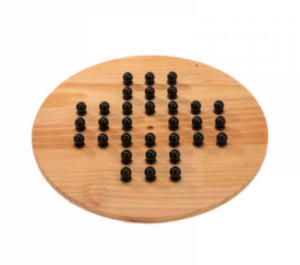
The first image shows you a sequential movement puzzle that requires you to move out the red colored block through the opening on the right by following a specific sequence and the second puzzle needs you to make a sequence of movements by keeping in mind a set of rules, such that there is only one marble left on the board.
4. Dexterity Puzzles
The term Dexterity literally means the ability or skill to do a complex task in a simple way by following fewer steps, especially with hands. Therefore dexterity puzzles can be solved by manipulating a piece of a puzzle with hands in a specific way to reach a predetermined goal.
Here is a tip for solving a dexterity puzzle game for you!! You can master dexterity puzzles with practice, and improving the flexibility in your palms and wrists can help you memorize the technique that works for you in terms of moving the piece to finish solving it. You have different subtypes like opening a lock, moving a set of metal balls to the center of a maze, cracking a secret code, etc.
Here is an example of a dexterity puzzle.
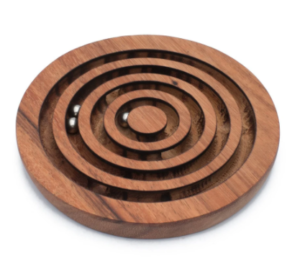
The puzzle in this image needs you to move all three metal balls into the center. It seems to be easy, but it isn’t!!!
5. Take Apart Puzzles
A typical take apart puzzle requires you to manipulate a solid puzzle made with different small pieces, to find ways to take them apart. Unlike a solid interlocking puzzle, this type of mechanical puzzle is relatively easier to start with solving puzzles as you can figure out the first step to make things apart. Knowing what is the first piece that needs to come out does not make it easier to finish the puzzle though!!
It is interesting to note that, there were a few take-apart puzzles patented by the USA, and the zenith of using a take-apart puzzle as a secret keeper took place in the late nineteenth century. The level of difficulty depends on the number of pieces used for crafting one solid puzzle or the complexity involved in taking the pieces of the puzzle apart.
Here is an example of a take apart mechanical puzzle.
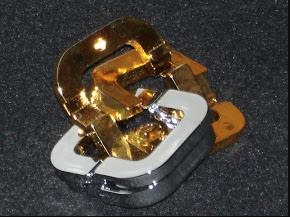
This mechanical puzzle requires you to take apart the silver and gold rings from each other.
6. Put Together Puzzles
Put-together puzzles are the oldest category of mechanical puzzles. The history of solving them dates back to the third century and it revived in the early nineteenth century. Most of these, have a set number of pieces that reveal a specific image or a picture or a secret code that is set by the puzzle creator. The most common type of put-together puzzle is a Chinese tangram with seven pieces. Modern-day put-together puzzles are more fun and interesting to solve as they are designed to reveal a three-dimensional figure.
This category of mechanical puzzles requires you to use the pieces and assemble them to find the predetermined solution. The user needs to remember the previous steps in order to make the next most probable right move, and also that the pieces have different combinations and only one of them is the correct one.
Here is an example of put-together puzzles.

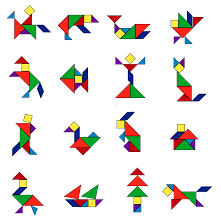
The first picture is a puzzle that requires you to form a tree house with the available pieces and the second one depicts various figures formed with a tangram.
7. Disentanglement Puzzles
The disentanglement puzzle is that category of the mechanical puzzle which requires you to disentangle a part of a piece made with two or more interlinked pieces. This type might also ask the solver to attach a piece in order to form the final structure. The materials used for designing these are metals, metal wires, large nails, strings, wooden rings, wooden handles, etc. The level of difficulty for this category depends on the number of interlinked that you need to disentangle.
The most common and the oldest form of disentanglement puzzle is a bent nail mechanical puzzle that requires you to separate all the nails used for designing it. Although it belonged to the early seventeenth century, it is tried by many puzzlers even today.
Here are a few examples of disentanglement puzzles.
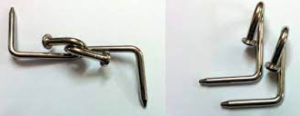
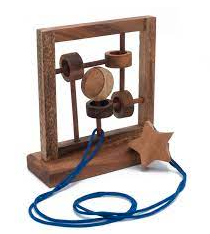
The first one is the most common bent nail mechanical puzzle and the second one requires you to separate the ring from the whole puzzle piece.
8. Solid Interlocking Puzzles
A solid interlocking puzzle is designed in such a way that it appears to be one single piece and inseparable. But in reality, they are made with several smaller pieces interconnected so well that it appears to be so. In this type of mechanical puzzle, you will be required to separate all the pieces interlocked to form one large piece.
The toughest challenge you need to face while solving a solid interlocking puzzle is that of fixing the last piece into the puzzle. Generally solid interlocking puzzles are made of wood or metal. However, we do not recommend buying those made with plastic as the shape of pieces is not well defined to be fit into a single large piece of the puzzle.
Here is an example of a solid interlocking puzzle.
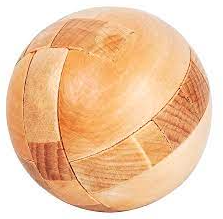
This puzzle needs you to form a circle with different pieces. Inserting the last piece is the toughest thing you’ll ever do to finish solving a solid interlocking puzzle.
9. Impossible Object Puzzles
Impossible objects puzzle is a mechanical puzzle that requires you to separate things used to form a single piece of the puzzle, that appears to be impossible to separate. A few of the varieties under this category of mechanical puzzles are removing an object from a glass bottle that is bigger than the bottle’s opening, pulling out a for fixed through a currency note, remove a screw from a wooden block, etc.
These appear to be impossible but they require a little physics to get solved. Understanding a few basic concepts of physics like friction, centrifugal force, centripetal force, gravity, etc is important for solving this category of puzzles. Therefore, these can be used for practicing these physics concepts.
Here are a few examples of impossible object puzzles

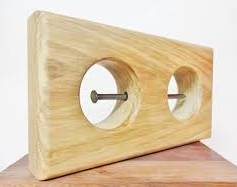
To solve the first one, you are supposed to take out the wooden rod that has two wooden balls of different sizes attached to it and the second one gets solved when you take out the nail from the wooden block without breaking the block.
10. Rotating Puzzles
A rotating puzzle is a type of mechanical puzzle that is designed in such a way that it involves rotation of one part of the puzzle and also the whole piece of the puzzle itself to obtain the solution. This type has many varieties and a few of them are designed using gears of different sizes, small cubes that are interlinked to form a bigger cube, etc.
Solving rotating puzzles is easier for a person who can remember the sequence of steps that took him to the closest of solving the puzzle so far. And a few varieties of rotating puzzles have a set of formulae to be remembered to save time and solve them quickly.
Here are a few examples of the rotating types of mechanical puzzles.
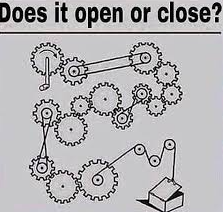
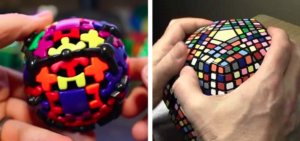
The first picture gives a mechanical puzzle that requires you to rotate the gears and tell us if the box open. The second one is the most common rotating puzzle, i.e; a Rubik’s cube.
Conclusion:
Mechanical puzzles are diverse in nature and are considered the toughest of all categories of puzzles. Different types of mechanical puzzles interest different age groups. A few of them like rotating puzzles, put together puzzles, folding puzzles, trick vessels, etc are enjoyed by the young adults, and the rest of them like sequential type, solid interlocking type, disentanglement, take apart puzzles are designed for teens, young adults and adults as well. The Impossible object type of mechanical puzzle is my most favorite. Find out your’s by checking out the article thoroughly and make sure to try them all.

